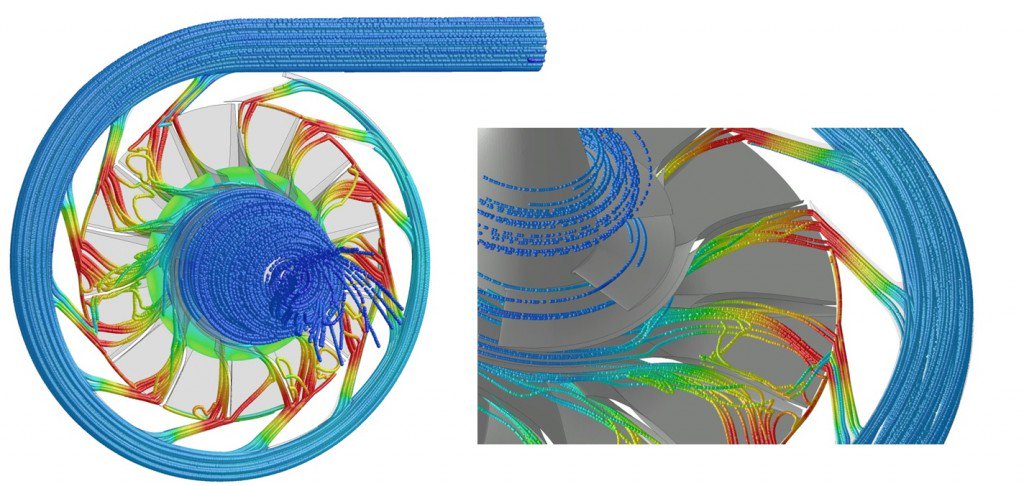Tuesday, July 23, 2013
Performance evaluation of micro gas turbine with CFD
By
Vijay Mali

A turbine is a rotary mechanical device that extracts energy from a fluid flow and converts it into useful work. A turbine is a turbo machine with at least one moving part called a rotor assembly, which has a shaft or drum with blades attached. Moving fluid acts on the blades so that they move and impart rotational energy to the rotor.
Micro turbines are small combustion turbines which are having output ranging between 20 kW to 500 kW which runs with high rotating speeds of 20,000 to 120,000 rpm. This innovative technology provides a solution to the scaling-down of higher power gas turbines. Normally they are combustion turbine that produces both heat and electricity on a relatively small scale. Micro turbines are becoming widespread for distributed power and co-generation (Combined heat and power) applications. Micro turbines offer several potential advantages compared to other technologies for small-scale power generation, including: a small number of moving parts, compact size, lightweight, greater efficiency, lower emissions, lower electricity costs, and opportunities to utilize waste fuels. Waste heat recovery can also be used with these systems to achieve efficiency greater than 80%.
We have performed the CFD based parametric simulations on Micro Radial Inward Turbine.This turbine was intended to act as power generation unit in waste heat recovery plants. The working fluid was refrigerant.
The performance calculated for this design was verified using CFD. The torque and power output values from CFD were with good agreement to the thermal design and sizing considerations for this small radial inward turbine. A comparative study between design parameters and CFD results implies the practical use of CFD to calculate turbine performance during the design optimization. Analytical calculations and CFD results of the design showed that the micro turbine did indeed perform as predicted, at the given speed and mass flow rate. It’s being immense pleasure to share some glimpses of the project.
Project highlights
To smoothly shade an object, a given vertex normal should be used by all polygons that share that vertex. Ideally, this vertex normal is the same as the surface normal at the corresponding point on the original surface. However, if the true surface normal isn't available, the simplest way to approximate one is to add all (normalized) normals from the common facets then renormalize the result. This technique was developed by Gouraud in 1971 and therefore also know as Gouraud Shading. This provides reasonable results for surfaces that are fairly smooth, but does not look good for surfaces with sharp edges.
The main requirement was to determine the torque developed and the power generated by the impeller for different working conditions. These conditions include same conditions at inlet (total pressure / flow rate), outlet (pressure), and various conditions for rotation speed of an impeller (RPM)
The high temperature, high pressure flow of refrigerant cannot be modeled accurately using the ideal gas assumption. Therefore, the NIST real gas model was used to model the physical properties of refrigerant accurately
The mass flow distribution at all nozzles was determined which was one of the performance criteria for turbine efficiency
Supersonic flow at small passages of through nozzles
The various pressure and temperature conditions at different locations throughout flow path was evaluated
Flow visualization inside the turbine geometry

We at CCTech can help you evaluating performance for your turbo machinery design. Infact we help people providing engineering solutions with help of powerful tool CFD. We assure reducing your design cycle time and cost. So let’s set up a meeting at your place.
About author
Vijay Mali
Vijay is a technology explorer, a visionary and a product maker. As CBO of the company, he plays a critical role in defining the growh path of the company. He also leads the center of excellence (CoE) department at CCTech which is responsible for exploring new technologies & building a strategy to bring it to common designers. Vijay has over 15 years of experience in providing the CFD solutions for many complex problems. He has conceptualized many software solutions including the Pedestrian Comfort Analysis & Control Valve Performer app developed on simulationHub platform. Vijay is known for his transformative way of teaching and trained more than 500 candidates on complex topics like computational fluid dynamics and design optimization. He has delivered talks at various events and engineering colleges about CFD and its use in design optimization of a product. Vijay holds a master degree in aerospace engineering from Indian Institute of Technology (IIT Bombay).
Comments
Recent posts




